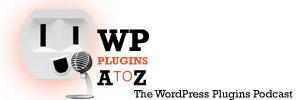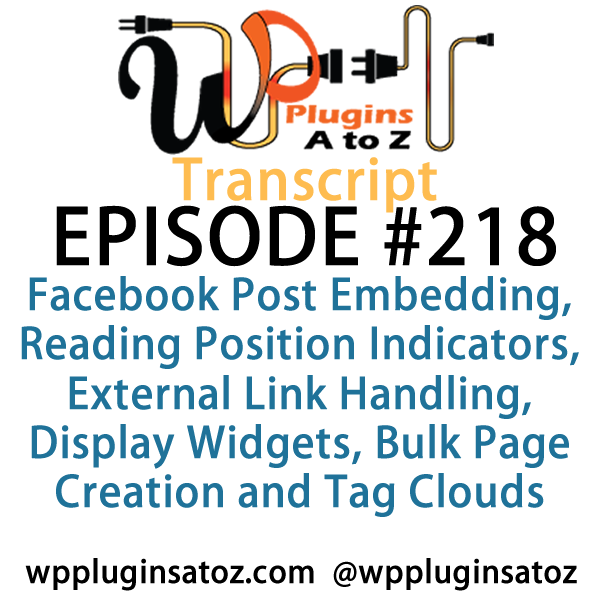All transcripts start from the point in the show where we head off into the meat and potatoes. They are the complete verbatim of Marcus and John’s discussion of the weekly plugins we have reviewed.
WordPress Plugins A to Z Podcast and Transcript for See complete show notes for Episode #218 here.
It’s episode 218 and we’ve got plugins for Facebook Post Embedding, Reading Position Indicators, External Link Handling, Display Widgets, Bulk Page Creation and Tag Clouds. It’s all coming up on WordPress Plugins A-Z!
Episode #218
John: All right, the first one I’ve got here for you out the gate is a way to manage external links on your website. Now it’s a given that sooner or later, you’re going to have to put links into your posts and pages that are going to lead off of your site. And when you’re putting those links in, it’s always best to have them open in a new page, instead of having people click and open up in the same page and lose track of your website. You want a new page that they can close and be back on your website.
Well, it’s not a default action in WordPress to have that happen. You have to manually click open a new page when you’re setting that link. Sometimes links are added automatically and it doesn’t add that default action. This plugin helps solve that problem for you. It’s called WP External Links and it’s a very simple, easy plugin to use. Basically, you just install it, turn it on, and activate it.
A couple of key things need to be set up on it. You need to tell it how it’s going to handle the opening of the links, whether it’s going to be a new page, the same page, top, bottom — wherever you want to do it. With this one, you can also set up a couple of essential SEO elements, like a no-follow tag and an external tag, so that helps identify what those links are on your website for SEO purposes.
And if you want to get fancy with this plugin, you can even add icons to those external links. I tried that and it’s okay. It’s not very pretty, so I turned it back off. But if you like that sort of thing, check it out. All in all, a great little plugin. It’s simple and easy to use and solves a problem. I gave this one a perfect 5-Dragon rating.
Marcus: Wow, very nice! Very nice. That’s cool. And does it do it by — can you set a default so that every link has a specific default, or do you need to set them up one by one?
John: No, it’s set as a universal default for the whole site.
Marcus: Oh, excellent. Do you have the ability to untick that and make it do something else besides the default in a post-by-post basis?
John: You know, I hadn’t thought to check into that, because I just wanted to be default throughout the whole website.
Marcus: All right, well, it was perfect for that. That’s the 5 out of 5 rating.
John: Yeah.
Marcus: Excellent. Well, the first one I’ve got for you here is called Easy Facebook Post Feed. It allows you to display a customizable and responsive Facebook feed within your posts. It’s really quick to use; you can use a widget or a short code, and you can customize the layout options, like the color, the border, the number of posts to display, choose it to display within an image if you want. And if you do that, you can choose the width and height or pixel percentage for the particular image.
It works right with the Facebook API, so all you need to do is enter your Facebook page ID and the Facebook API does all of the rest. So it’s a very cool way to kind of put in all of the things for your Facebook page out there and integrate it right within your website. I give this one a 4 out of 5.
John: Very nice. And more and more these days, you need to bring your Facebook stuff over. Hey, the easier it is, the better.
Marcus: That’s right. The only thing that I don’t like about this is its still API-driven, so it doesn’t actually make a hard copy within your database. So someday, when the world collapses and Facebook goes down, you’re going to lose your content but oh well.
John: Yeah, well there’s that limitation but something good. All right, well the next one I’ve got up here, this is a plugin that I know is no longer so much en vogue as it was. It’s called Ultimate Tag Cloud Widget. Now of course, once upon a time, tag clouds were everywhere. Every website you went, tag clouds, flash tag clouds — they were the coolest thing for a while. Then we found they weren’t all that useful or nobody paid attention to them.
But every once in a while, you’ll build a website where the tag cloud is an essential component to the site, such as if you go to Canada Stock Photography, the tag cloud is an essential component. It makes it easier to navigate to different categories of words that associates images together. So in that process, you’ll want a nice, clean way to display the tag cloud aside from the default WordPress way and you’ll want to limit the number of tags that are there. You might want to give them some color coding and size differentiations.
Well, that’s what this plugin does for you. It’s a great plugin for it. It’s very simple, it works well, and it’s actually being kept up to date. A couple of tag cloud widgets I used to use haven’t been touched for two to three years. So check this one out. I gave it a 4-Dragon rating: The Ultimate Tag Cloud Widget.
Marcus: Cool. Yeah, in the sense of photographs, yeah, tag clouds would be very beneficial.
John: Yeah.
Marcus: Sometimes just for posts; maybe not so, but for particular items or if you have a product store or anything like that, those are great to use.
John: Yeah, they’re great when you have something that the images might not be the same or are from different categories but still share a similar tag word. This way, you can group things together and make it easier for people to find them.
Marcus: Awesome. All right, well the next one I’ve got is something based out of necessity for a brand-new website that I’m creating. It is called Quick Bulk Post and Page Creator. Now there are a number of different bulk post and page creators out there on their own. Some of them do one, some of them do the other. This one though is interesting because it actually allows you to create hierarchy or parent-child relationships of posts and pages, right within the bulk creator.
So you just basically set in the titles and if you want to do a child or a subpage or whatever within that, you just put a dash in front of the title, and then it creates it right underneath the non-dashed version. So it allows you to basically create an entire setup of different posts and pages, all within this one plugin. I found it very useful and I rated it a 4 out of 5.
John: Very nice. That could definitely save some time on initial setup. All right, and then the final one I’ve got here for you is a way to manage your widget displays. This is called Displays Widgets and through the last few years, I’ve gone through various plugins to manage the widgets and how they show on a page. There comes a time when you’re going to need to hide or show a widget on a particular page or post.
And in particular, this happens when you’re doing things such as creating a membership site. You’ll have your subscription page and then you have a widget in the sidebar that also allows people to sign up. You don’t need both of them showing up on the same page; you need to hide one. So this is a great plugin for it. It’s one of the simpler ones that I’ve discovered. It’s very easy to set up. You just turn it on, go to your widgets, and you end up with a new menu in your widgets there, which will allow you to choose whether to show or hide the widget. Then you can choose what particular pages to show it on.
As far as posts go, you can only choose to show it in specific categories or tags. You can’t go on a post-by-post basis, unless you’re setting it up through the post itself. Other than that, this is a great plugin. I found it to be very useful to hide and show the widget on command when I need to. It works for categories, taxonomies, posts, and pages. Check it out: Display Widgets. I gave it a 4-Dragon rating.
Marcus: That’s very nice. Well, the final one I’ve got is something that was submitted to me by a listener. The listener is not the one that created this but they wanted me to take a look at this and see if it would fit the bill for what they were looking for. It’s called Reading Position Indicator, and it’s a relatively new plugin.
What it does is it creates a vertical progress bar to show how far down somebody’s actually scrolled on the page. You can set two different colors, like green and red for the two gradients and it will kind of change color from green to red, based on how far down you’ve gone or vice-versa. I tried this out and it does definitely work as advertised.
But for the life of me, I can’t figure out why in the heck you would use something like this, unless of course you have a post that’s infinitely hugely long and scrolly and all of that kind of stuff. If it were for multiple pages or something like that within one post, I could definitely see that if it were broken up and then you could see how far along you were, kind of like how Gravity Forms Progress Bar works. But for this one, I just don’t see a use for it.
I don’t know exactly what the listener was looking for out of this plugin and why they happened to ask me to review it, but I’m happy to do so. It does work as advertised but I just can’t figure out what you’d use it for, so I rated it a 3 out of 5.
John: All right. I must have missed it — is this a front-facing, user facing –?
Marcus: Yes.
John: Okay, so yeah, I don’t see aside from maybe telling people how far they’ve got to read in a post. But I could see it as useful if it was a back end sort of thing and you’re trying to figure out how far people are tracking down through your posts.
Marcus: Yes.
John: But no — I’ve sort of experimented with these things in the front of the page. I don’t see a real value them, either.
Marcus: Yeah, the only thing I could see is if okay, they get to the 60% scrolling down thing and fire off a pop-up or something like that that advertises something. But for the life of me I’m not quite sure why this was made.
John: Okay. All right, well I covered up in this episode here WP External Links, which I gave a 5 rating to, the Ultimate Tag Cloud Widget, which I gave a 4 to, and then the Display Widgets, which I gave a 4 to.
Marcus: And I talked about Easy Facebook Post Feed — I gave that one a 4 out of 5, Quick Bulk Post and Page Creator — 4 out of 5, and we just discussed Reading Position Indicator, which I gave a 3 out of 5.


